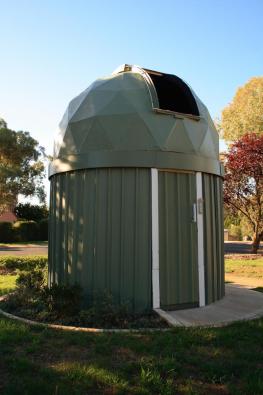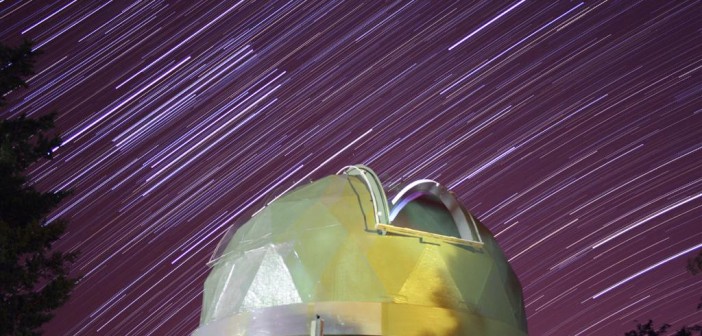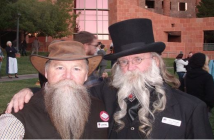As a kid, Barry Armstead was a huge fan of Star Trek and Dr Who. He watched documentaries on space and dreamed of becoming an air force pilot so he could fly close to the outer rim.
Instead, Barry joined the army, and on returning from active service in East Timor he decided to build an observatory. This was his very own Tardis – in the front yard of his house – that could transport him through time and space … if only through lenses.
Astrophotography is the art of taking photographs of objects in space. Aficionados use telescopes, digital cameras and other sensitive equipment and spend hours capturing time-lapse images of various cosmic phenomena, be they the moon, the Milky Way, solar flares, quasars or dense galaxies. It’s an exact science and a fairly solitary pursuit. However, the results are breathtaking and assuredly out of this world.
“Star gazing has always been a fascination,” Barry says.
“The universe is so perfectly designed that all I can see is a big plan. Everything works co-dependently, and if you were to remove any one of those co-dependent systems then life as we know it wouldn’t exist. I can’t see that as an accident.
“When I came home from East Timor I had a heap of money and was wondering what to spend it on. A lot of my mates were buying new cars, but I thought I’d buy a telescope, and it went from there.
“I started doing remote observing when I lived in Sydney, driving out to the bush and watching the stars. When I moved to Canberra the sky was a lot darker and a lot less polluted by light. I had room in the front yard so I decided to build a small observatory.
“It’s hard work dragging a telescope out and setting it up every time. You get sick of the cold, dew and wind, so it makes sense to have a permanent set-up: you can walk in, switch on and away you go.”

Barry took his time to get the observatory right and turned to other backyard stargazers for advice.
“I did a lot of research on the internet and got in contact with guys around the world who had built their own units. Most of them had built architecturally designed models, but I didn’t have the money to do that, so I combined aspects of what they had done with a couple of my own ideas.
“I thought hard about the plans and materials, made a lot of notes and sketches, and came up with many alternatives before submitting a detailed plan to the local council.
“The first guy I spoke with said no. I called back a few days later and got a different guy, who said yes. If I kept it under three metres in height, with a floor plan of less than 25 square metres, and did not paint it white or off-white, then it would be a class-10 building and I wouldn’t need building approval.”
The observatory was built on a tight budget. Most of the materials were free – recycled or found on the side of the road.
“I tried to use materials discarded in the building and transport industry. It is a shame to see such versatile and valuable resources destined for landfill when something beautiful or creative can be made out of them.
“I spent about $140 on sand and cement for the foundations. Formwork was scrap wood and flexible plastic sheeting, and most of the plywood was liberated from the rubbish pile at a transport depot.
“I bought nuts, bolts, glue, screws, etc, from local hardware stores. Fibreglass was the most expensive part. I spent just over $700 for the 17 square metres I needed.”
Fate – or perhaps the universe – took care of the rest.
“I don’t believe in coincidence, and someone was definitely looking out for me while I was building the observatory. Just when I needed something, fate would step in and deliver it right into my hands.
“I needed floor covering and found a perfect roll of carpet at the tip. I needed 50 metres of conduit and was doing a delivery to a factory – and there was a roll out the front that they were throwing out.
“A few weeks later I came across a guy who had a drop saw sitting in his driveway. He was trying to get rid of it because it was too big for his workshop and asked if I wanted it. It came at the perfect time because I was sick of using my blunt handsaw.
“When I was building the structure people walking by made bets as to what they thought it was – an aviary or a gazebo.”

Barry is about to start building a bigger and better observatory – as long as the council approves, of course.
“It will still be in the front yard. The existing observatory has become a bit of a Canberra landmark. Local people, tradies, couriers, and taxi and truck drivers use it as a guide.
“The new one will have a five-metre dome so there will be more room inside for visitors. I could fit five or six people inside the old one fairly comfortably, but more room means there is less chance of people bumping the sensitive equipment or tripping over cables and leads.”
A bigger and higher structure also means the dome can accommodate the telescope alone, leaving enough room for a small office underneath.
“The telescope will be mounted on a platform. There will be desks, chairs and computers towards the back and on the other side a short spiral staircase that will take you up into the dome.
“Ultimately, I would like to automate the dome so that it operates in unison with the telescope. That way, people all over the world could dial in, book time, remotely open the dome, set the telescope up and start doing research. Or they could just enjoy the incredible sights out there in space.
“I love the space in the observatory itself. I go out there at night and it’s my quiet time, my thinking time, and I enjoy the solitude.
“I’m a night owl. After 10pm is when I really start firing. I set the cameras and the telescopes up to take 20-minute exposures for the rest of the night. I can get up to 15 hours on one object over a few clear nights.
“It varies from night to night, but if I’m having a really good run and there are beautiful clear skies then I stay there till the sun comes up.

“I photograph stars and nebulas and things like that. There are up to 400 billion stars in our galaxy and they are beautiful and fascinating. But I look between them and out into the voids, to galaxies millions of light years away that have billions of stars of their own.
“The farthest I have seen is 33 million light years away. When I build the new observatory, I want to better that.
“I’m all about the enjoyment of it – and perfecting the imagery and being able to share that with people. It’s an expensive hobby. You could be looking at $80,000 by the time you get the dream telescope.
“The dream observatory is not really about making it bigger and better but about making it more comfortable.
“Eventually I would like to have people in there on a regular basis.
“Once people get a first-hand
look through a telescope and see the rings of Saturn and the clouds on Jupiter for themselves, instead of in a book or on telly, it opens up their worldview and their four walls come crashing down.
“For some people it can be life changing. It certainly changed mine.”




